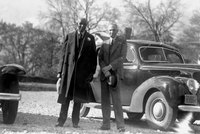George Washington Carver and Henry Ford Shared a Bio-fuel (Ethanol) Vision
 George Washington Carver and Henry Ford shared a vision of a future in which agricultural products would be put to new uses to create products and industries. |
Originally Published February 18 2007 on The Auto Channel
DEARBORN, MI - February 18, 2007: Though worlds apart, George Washington Carver and Henry Ford shared a vision of a future in which agricultural products would be put to new uses to create products and industries.
One idea both men worked on more than 60 years ago -- biofuels -- is again in vogue as America seeks to reduce its dependence on foreign oil.
"Henry Ford was ahead of his time on this. He knew he needed fuel for transportation, and if he could develop something that was good for agriculture too, it would be a good match," said Dick Baker, a tech leader at Ford's powertrain, research and advanced engineering department.
"Henry also knew of Carver's work and said 'that's somebody I need to learn more about,' " said Baker.
That was because Carver, born a slave in Missouri during the Civil War, had become a world-famous botanist by the 1930s, famed for his research into the many uses of peanuts, soybeans and other plants. Over the years, Carver promoted the idea that such plants could be turned into plastics, paint, fuel and other products.
Ford was interested in the same things. Besides his legendary work creating plastic car parts derived from soybeans, Ford had long believed that ethanol (or grain alcohol) should be produced as an alternative fuel.
"All the world is waiting for a substitute for gasoline," Ford said in 1916. "The day is not far distant when, for every one of those barrels of gasoline, a barrel of alcohol must be substituted."
During the early days of Prohibition, he even suggested turning Michigan's idled breweries into distilleries to make denatured alcohol for fuel in cars and trucks, noted historian Ford Bryan. That went nowhere since Prohibition doomed the idea of any large-scale switch to alcohol production.
The automaker learned of Carver following his donations to the Tuskegee Institute (now Tuskegee University) in Alabama where the botanist was a faculty member, Bryan said.
At Tuskegee, Carver had promoted the use of crop rotation -- planting such nitrogen-rich crops as peanuts, sweet potatoes and soybeans -- to improve farmland depleted by years of raising cotton. In so doing, he also worked on hundreds of new uses for such crops.
Though he's often credited with inventing hundreds of uses for the peanut alone, Carver left few formulas or detailed records, making such claims by admirers hard to verify.
By the late 1930s, Carver and Ford were corresponding on a variety of subjects, including new industrial uses for soybeans and other plants. Ford had also met with Carver in Dearborn and at Ford's estate in Georgia and visited him at Tuskegee.
At first glance, they must have seemed like a strange mix -- the billionaire industrialist from the North and the modest scientist and naturalist from the South. But Ford regarded Carver as a contemporary. Both men had been born on farms during the Civil War and both had sought, in their own ways, to improve the lot of the common man.
After Thomas Edison died, the automaker even called Carver "the greatest of all my inspiring friends." To honor him, Ford also had a replica of Carver's log cabin birthplace built amid the other historic buildings at Greenfield Village in Dearborn. In addition, Ford helped outfit a laboratory for Carver and had an elevator installed in a Tuskegee dormitory so the botanist could get to his lab more easily in his later years.
While certainly forward-thinking, the idea that agriculture could be used to create alternative fuels wasn't totally new with Carver and Ford. The German inventor Rudolph Diesel had created an engine that ran on peanut oil in 1900. But both Carver and Ford believed that petroleum supplies would one day become limited. And both promoted the alternative uses of soybeans, which Ford used to make car parts in the 1930s.
This interest culminated in 1942, when Ford showcased a car with a plastic body made from soybeans. Attached to a tubular frame, the body weighed 30 percent less than a steel car and was much more flexible and durable. The experimental car was also equipped to run on ethanol rather than gasoline but such a novel idea failed to catch on.
By that time, huge new oil fields were being discovered and petroleum had become much more cost-effective than plant-based ethanol, said Baker.
"Agricultural fuels take a fair amount of processing to create, whereas petroleum comes out of the ground and just needs refining," Baker said. "The principles were right for what Ford and Carver were doing in the lab, but they didn't have the tools we do now to go big-time with the idea.
"Now, we're revisiting their old story with new tools, and exciting things are going on in the laboratory again," he said.
More than 60 years later, the ethanol-fueled dreams of Carver and Ford are becoming a reality.


